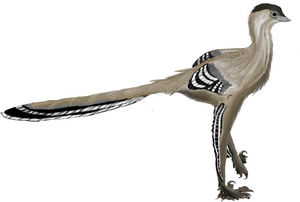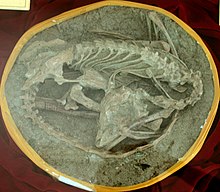Mei (dinosaur)
| Mei | ||||||||||||
|---|---|---|---|---|---|---|---|---|---|---|---|---|

Life reconstruction of Mei |
||||||||||||
| Temporal occurrence | ||||||||||||
| Lower Cretaceous ( Hauterivium ) | ||||||||||||
| 133.9 to 130.7 million years | ||||||||||||
| Locations | ||||||||||||
| Systematics | ||||||||||||
|
||||||||||||
| Scientific name | ||||||||||||
| Mei | ||||||||||||
| Xu & Norell, 2004 |
Mei is a genus of dinosaurs from the Troodontidae familywithin the Theropoda . This little dinosaur lived in the Lower Cretaceous in what is now China .
features
The almost completely preserved skeleton of a not yet fully grown animal has been preserved from Mei . It is around 0.5 meters long, the animal should have reached the size of a turkey . Like all representatives of the Troodontidae, it was a slender, presumably carnivorous dinosaur. The integument has not been preserved , it is not known whether Mei was feathered . What was special about Mei's discovery was that the animal apparently died in its sleep and its posture can be seen. The head was tucked under the left arm - an attitude that is also present in modern birds - and the tail wrapped around the body.
Discovery and naming
The fossil remains of Mei were found in the Yixian Formation in northeast China's Liaoning Province and first described in 2004 . The type species and the only known species is Mei long . The name comes from the Chinese , mei (寐) means "deeply sleeping" and long (龙) means "dragon". After the name Yi , Mei is the second shortest generic name of a dinosaur.
The finds are dated in the Lower Cretaceous ( Hauterivium ) to an age of 134 to 131 million years.
Systematics
Mei is systematically incorporated into the Troodontidae . He is considered a relatively primitive representative of this group and is likely to have been closely related to Sinovenator . The bird-like sleeping posture is a further indication of the ancestry of the birds from the theropods and makes it clear that many bird-typical behaviors were probably already present in this group of dinosaurs.
literature
- Xing Xu , Mark A. Norell : A new troodontid dinosaur from China with avian-like sleeping posture. In: Nature . Vol. 431, No. 7010, 2004, pp. 838-841, doi : 10.1038 / nature02898 .
Individual evidence
- ^ Alan H. Turner, Diego Pol, Julia A. Clarke, Gregory M. Erickson, Mark A. Norell : A Basal Dromaeosaurid and Size Evolution Preceding Avian Flight. In: Science . Vol. 317, No. 5843, 2007, pp. 1378-1381, doi : 10.1126 / science.1144066 , PMID 17823350 .
